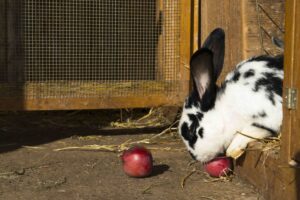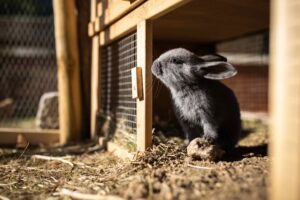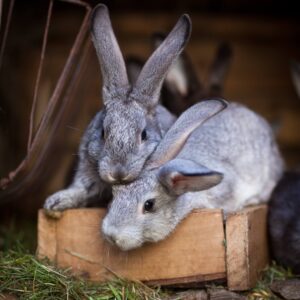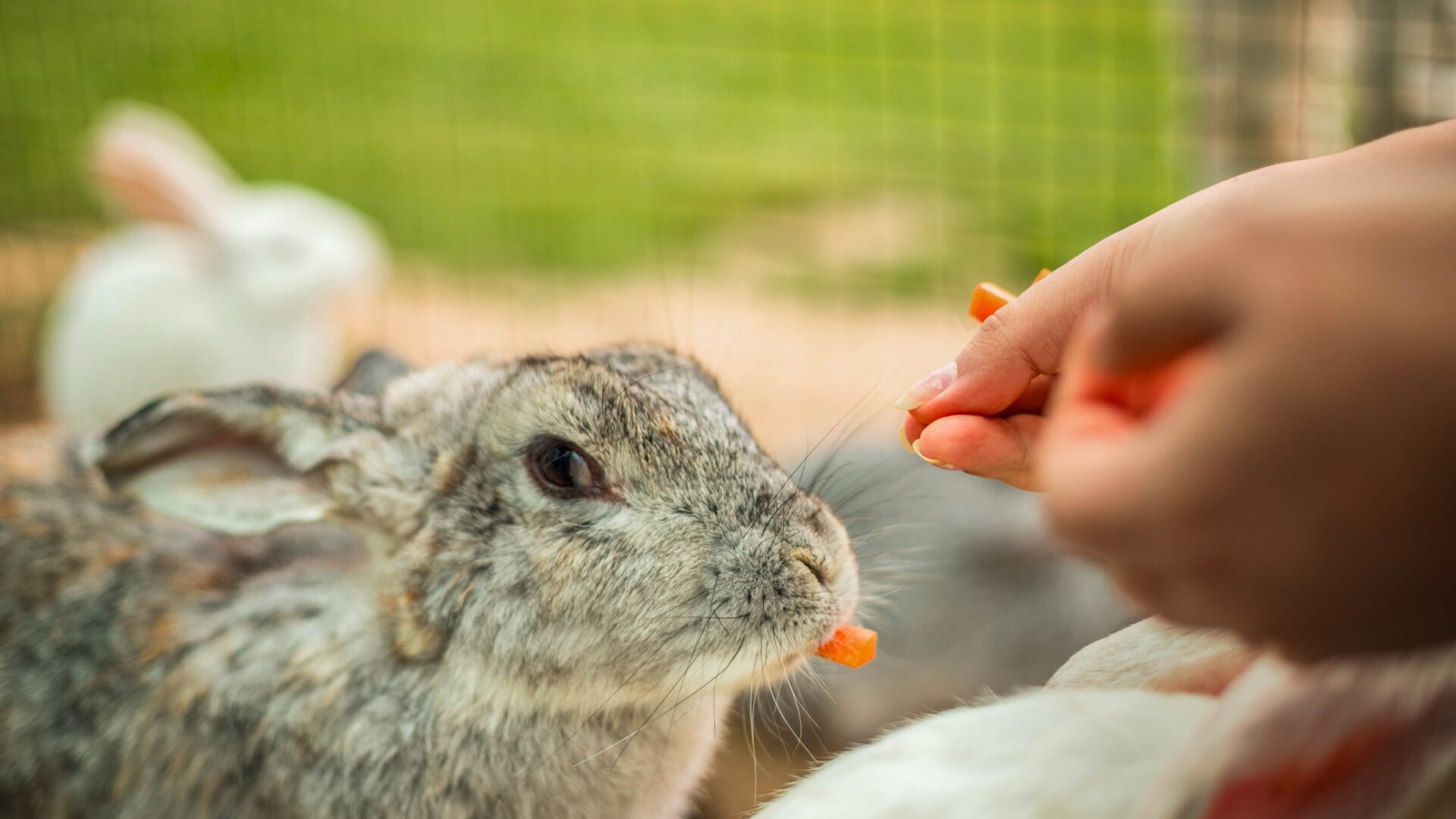Updated: 12/05/25
When housing rabbits, the most important thing to remember is that they need as much space as possible.
Housing rabbits solely in a hutch with no access to a run is not recommended, and does not meet their welfare needs.
There are lots of options for providing spacious, optimised or, even better, enriching accommodation for your rabbits to ensure they have a home that supports their physical and mental health.
On this page:
- How much space do rabbits need?
- Outdoor rabbits
- Indoor rabbits
- Litter training
- Keeping rabbits entertained
- Bedding materials
How much space do rabbits need?
It is important to remember that rabbits need companionship and should always be kept in pairs (you can read more about the importance of this and how to bond rabbits here).
For two standard-sized rabbits, the Rabbit Welfare Association and Fund recommend a minimum living area of 3m x 2m by 1m high on a single level, including their sleeping area. Within this, your rabbits’ sleeping area (for example, a hutch or cage) should be a minimum of 1.8m x 0.6m by 0.6m high. Many rabbit hutches sold in the UK do not meet these minimum recommendations.
Your rabbits should have constant access to both their living and sleeping areas and should never just be confined to a hutch.
These housing measurements allow rabbits to exhibit almost a full range of natural behaviours, including having the space to run, jump, binky, stand up and hide.
Upper stories, tunnels, etc, are all welcome additions to your rabbits’ housing, but should not be used in place of a smaller ground floor space.
These are minimum space requirements for rabbits, and their accommodation can be much bigger and more extensive than this.
Many rabbit owners get very creative in designing their rabbits’ homes, even adapting outbuildings and garden sheds!

Outdoor rabbits
Outdoor rabbits’ housing will need to meet the minimum space requirements outlined above and ideally be larger if possible.
When planning accommodation for your rabbits, the aim is to house them in a way which allows them to exhibit all the natural behaviours they would in the wild and space is key to this.
Rabbits kept in confined housing are much more likely to suffer from health problems, including obesity, sores on their feet and arthritis (stiff, painful joints).
The ideal setup is a private, sheltered sleeping area within or attached to a living/exercise area.
As rabbits are most active at dawn and dusk, they should have constant access to both of these areas so they can exercise at any time. They should never just be confined to a hutch.
For this reason, it is also important that your rabbits’ housing is safe and secure, both from predators and from bunny escape artists!
Heavy gauge mesh is better than chicken wire and should be well attached to the frame.
Ensure you select pet-safe paints or stains when you are treating any timber. It’s also safer to use bolts that can be padlocked.
Be aware of your rabbits digging, especially if they are on grass, as they may easily tunnel out!
Wire mesh skirts or paving slabs around the edge of the run may help to prevent this.
Alternatively, the run can be moved onto an area of hard standing and a digging pit provided.
Be aware that not all plants and garden products are safe for rabbits, so check if any plants they have access to are considered toxic, and keep any garden treatments, pest control products, weed killers, etc, away from your rabbits and their housing.
Avoid setting your rabbits’ housing up in an area which sits in direct sunlight.
Shade must be provided in hot conditions, as rabbits easily get heat stroke. Ideally, the housing should have some shelter from the weather, for example, ‘run covers’ can be used to keep the rain off.
During cold winter months, watch the water for freezing and provide lots of bedding and fibrous food. It is also important to cover the house with a blanket or quilt and waterproof material during very low temperatures.
Where possible, also consider between-wall insulation for your rabbits’ housing to prevent extreme fluctuations in temperature.

Indoor rabbits
Indoor rabbits’ housing will need the minimum space requirements outlined at the start of this article, and rabbits will also need access to an area where they can feel safe and hide.
Even if your rabbit is living inside with you, they will still need the companionship of their own kind, and it is recommended to keep them in pairs (male-female neutered pairs often work best, and you can read more about how to bond rabbits here).
Although rabbits can make very good indoor pets, this is not without some level of commitment, as you will need to make certain adaptations to ensure your home is safe and bunny-proof!
When deciding how your indoor rabbit will be housed, several different factors will need to be considered, including what other pets you have, how safe certain areas are and the risk of your rabbits escaping.
Depending on their individual circumstances, owners may allow their rabbits to roam freely, have a designated ‘rabbit room’ or may pen off a safe area where their rabbits can live.
Given rabbits’ ability to get up to mischief, it is sensible to make sure they are confined to a safe area such as a pen when they are not supervised.
It’s important to think about potential dangers which may cause your rabbits harm.
For example, rabbits will need to be kept away from electric cables, or these will need to be protected from chewing using a cable protector.
It is always sensible to make sure that house plants are nontoxic and kept out of your rabbits’ reach.
Some floor surfaces, such as laminate, may be slippery underfoot for rabbits, and one solution is to use rubber-backed mats to provide more grip underfoot and reduce the risk of injury.
You will also need to decide whether your indoor rabbit will have access to the garden. While play time outside is a brilliant exercise for your rabbits, care should be taken to avoid severe changes in temperature and exposure to bad weather, particularly if your rabbits have become used to living indoors where it’s warm and dry!
Litter training
Rabbits are generally easily litter trained. However, they must be supervised when loose in the home to avoid accidents.
Litter training can be initiated by placing a tray in an area where your rabbit often toilets.
Low trays are better for access, and paper litter is safer than cat litter, which can be harmful if eaten.
To get your rabbit started, put some droppings into the tray daily until they are regularly using the litter tray themselves.
Keeping rabbits entertained
Whether your rabbit lives inside or outside, they will still enjoy different forms of enrichment to keep them busy and stimulate natural behaviours.
You can enrich your rabbits’ housing in a number of different ways, including providing toys, digging pits, tunnels and hides, offering access to grass or scattering/hiding food to encourage foraging behaviours.

Bedding materials
Be careful of dusty bedding, such as sawdust. Newspaper and good-quality, dust-extracted soft bedding is often safer than sawdust and dusty straw, as these may lead to respiratory problems.
Bedding must be kept dry to avoid humidity, which predisposes rabbits to respiratory disease and may damage their feet.
Clean out urine-soaked bedding daily to stop flies from being attracted to the housing. If flies are attracted, they may lay eggs on your rabbit, which can result in flystrike.
Useful resources:
- RWAF – Space recommendations: https://rabbitwelfare.co.uk/rabbit-care-advice/rabbit-housing/space-recommendations/
- RWAF – Indoor Rabbit Housing: https://rabbitwelfare.co.uk/rabbit-care-advice/rabbit-housing/indoor-rabbit-housing/
- RWAF – Outdoor rabbit housing: https://rabbitwelfare.co.uk/rabbit-care-advice/rabbit-housing/outdoor-rabbit-housing/
- RWAF – Enrichment: https://rabbitwelfare.co.uk/rabbit-care-advice/behaviour/enrichment/
With many thanks to Deborah Stafford MA VetMB MRCVS GPCertExAP for contributing to this content.
Found this article useful? You may also like:

